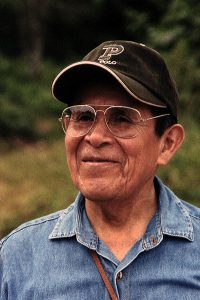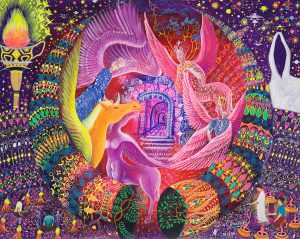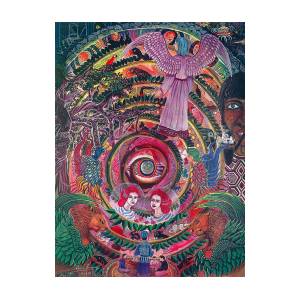“The consciousness of plants is a constant source of information for medicine, alimentation, and art, and an example of the intelligent and creative imagination of nature.” (Pablo Amaringo)
Every once in a while, the world is gifted with visionary artists, ones who see beyond boundaries and are able to communicate their vision in vibrant, life-affirming ways, ways that are in sync with the ethos of a movement that is embracing shamanic discernment via psychedelic means. Such is Pablo Amaringo. Born in Peru during the Great Depression, Amaringo drew his inspiration for his psychedelic infused art from his experiences with ayahuasca, a plant known for its ability to create spiritual-level transformative trips that enable people to connect to the vitality of shamanistic practices dating back centuries, thus creating a hallucinogenic and psychic link with our collective past that is soaked in the ancient wisdom.

Amaringo’s peculiar gift was to translate his visionary experiences into intensely colorful, hypnotically beautiful paintings,”. . . where snakes, jaguars, subterranean beings, celestial palaces, aliens, and spacecraft all converge” and present “a doorway to the transcendent worlds of ayahuasca intended for contemplation, meditation, and inspiration.” And although Amaringo lived in poverty the majority of his younger life, he eventually was able to capitalize on his art, and more importantly, share his intense visions with the world, due to his meeting with the ethnobotanist Dennis McKenna, brother of Terence McKenna, who traveled to Peru and made the Western world aware of his work.
The artist Tola Brennan writes that “The international success of his painting brought him the funding to co-found the Usko-Ayar School of Painting along with Luis Eduardo Luna in 1988. Based in Pucallpa and dedicated to the local youth, Amaringo’s school is free of charge and former pupils may eventually become teachers.”

Source: ineartamerica.com
Sam Woolfe, a freelance writer and blogger based in London, describes Amaringo as a vegetalista, “which is a traditional word for a shaman in Latin America who works with plants and vegetables to cure physical and spiritual illnesses.” Woolfe writes that Amaringo’s shamanism led him to “travel to places like Huanuco, Cuzco and Iquitos in order to heal people” where he “encountered spirits in every one of his sessions” that “came in the form of angels, mythological creatures, animals (the jaguar and snake especially) and princes.”
Out of these trance-like experiences, Amaringo was inspired to produce art that echoed the mystical magic he encountered in his trips. In the process, Amaringo believed that he captured not only the essence of an infinitely expanded consciousness but also the essence of vegetalista, saying “Every tree, every plant, has a spirit. People may say that the plant has no mind. I tell them that the plant is alive & conscious. A plant may not talk, but there is a spirit in it that is conscious, that sees everything, which is the soul of the plant, its essence, what makes it alive. The channels through which the water & sap move are the veins of the spirit.”

For Amaringo, his art was merely a vessel to capture the uncapturable, the essence of the universe which is present in all people, but inaccessible due to vision that is clouded by beliefs and filtered by socialized perceptions. As Amaringo so eloquently put it, “The pictures are a means by which people can cross spiritual boundaries. Some people say they can only believe what they see, but there are things which exist which cannot be seen. The pictures are for reminding people what we are, and where we come from, and where we are going. They are for people of any culture in the world, although there is much that is taken from indigenous Amazonian culture.”
There is an almost archetypal vibe that images form Amaringo’s paintings. As Woolfe points out, “. . . common themes in these paintings seem to be helper beings, snakes, the double helix, flying saucers, the inside of religious buildings, alien cities and a psychedelic, neon-coloured jungle.”
And though Amaringo passed from this earthly realm in 2009, it is almost as if through his paintings, Amaringo is able to project his eternal consciousness onto the viewers, whose contemplation perpetuates the mystical state that ayahuasca imbued upon his soul. As Amaringo said, “From experience, I came to learn that ayahuasca bestows upon the user knowledge about a variety of topics, not only consciousness and perception, but also leads one to realize that what we perceive is an illusion.”
At Newsweed.com, we adhere to three simple principles: truth, balance, and relatability. Our articles, podcasts, and videos strive to present content in an accurate, fair, yet compelling and timely manner. We avoid pushing personal or ideological agendas because our only agenda is creating quality content for our audience, whom we are here to serve. That is why our motto is ”Rolling with the times, straining for the truth.”
Your opinion matters. Please share your thoughts in our survey so that Newsweed can better serve you.
Charles Bukowski, the Los Angeles beat poet that captured the depravity of American urban life once said, “There is something about writing poetry that brings a man close to the cliff’s edge.” Newsweed is proud to stand in solidarity and offer you a chance to get close to the cliff’s edge with our first Power of Poetry Contest. Are you a budding bard, a versatile versifier, a rhyming regaler? Do you march to the beat of iambic pentameter, or flow like a river with free verse? If so, here’s your opportunity to put your mad poetic chops to the test. Enter our poetry contest for bragging rights and an opportunity to win some cash!






